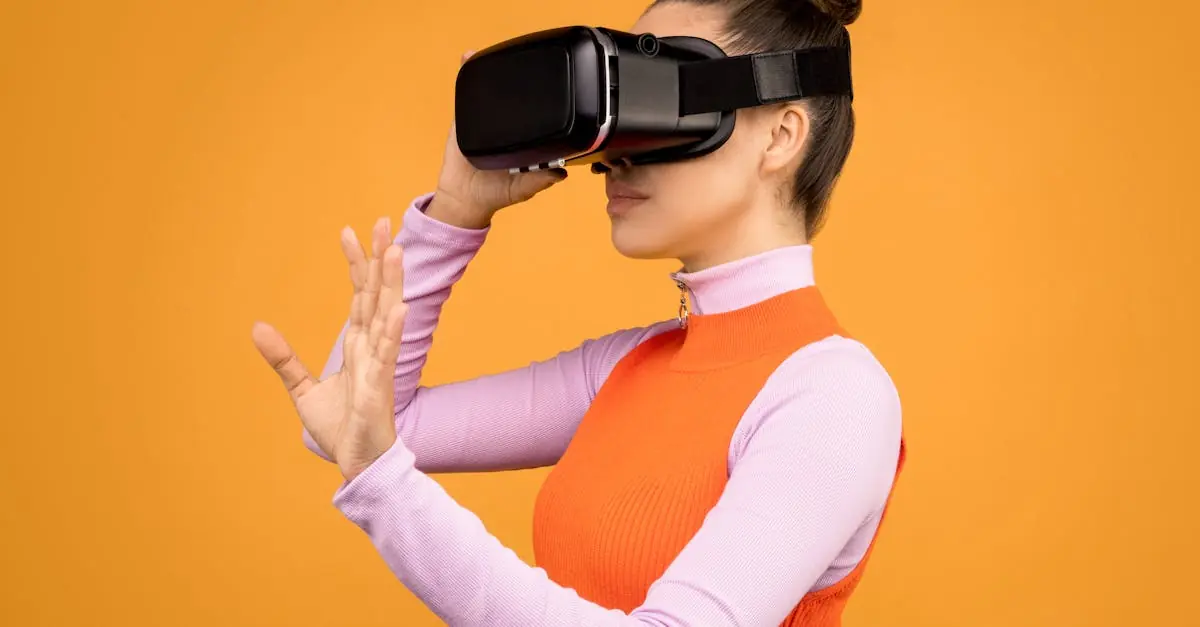In a world where reality sometimes feels a bit too real, virtual and augmented reality swoop in like superheroes, ready to save the day. Imagine stepping into a video game where you’re not just a player but the main character, or spotting a dinosaur casually chilling in your living room. Sounds like a sci-fi movie, right? Well, it’s not!
Table of Contents
ToggleWhat Is Virtual Reality?
Virtual reality (VR) creates immersive environments that transport users into simulated worlds. Users experience sensations resembling reality through headsets and controllers.
Definition of Virtual Reality
Virtual reality refers to a simulated experience that can immerse users in real or imagined environments. This technology uses computer-generated graphics, sound, and other sensory outputs to create an engaging user experience. Users often wear VR headsets that block out the physical world while becoming fully absorbed in a virtual space. Applications span across various fields including gaming, education, healthcare, and training.
Key Features of Virtual Reality
Key features of virtual reality enhance user interaction and engagement. First, immersion allows users to feel present in a different environment. Second, interactivity enables real-time responses to user actions, creating a dynamic experience. Third, 360-degree views provide a complete visual perspective, making the virtual world seem alive. Fourth, sensory feedback engages users through sounds and haptic sensations. Finally, social VR features enable users to connect and collaborate with others within virtual spaces.
What Is Augmented Reality?
Augmented reality (AR) enhances the real-world environment by overlaying digital information. This technology allows users to interact with virtual elements while still perceiving their physical surroundings.
Definition of Augmented Reality
Augmented reality refers to technology that superimposes digital data onto the real world. It combines digital graphics, sounds, and other sensory enhancements with real-time environments. Users experience this integration through devices such as smartphones, tablets, and AR glasses. Popular AR applications include games like Pokémon GO, where animations interact with the user’s real context.
Key Features of Augmented Reality
Key features of augmented reality include the blending of digital content with the real world. Interactive simulations allow users to manipulate virtual objects seamlessly. Mobile accessibility ensures widespread availability, making AR experiences accessible on various devices. Real-time interactivity creates dynamic user engagement. Among industries, examples include education, where AR aids in visual learning, and retail, where AR enhances product visualization.
Comparison of Virtual Reality and Augmented Reality
Virtual reality and augmented reality differ significantly in their user experiences and applications.
Differences Between Virtual Reality and Augmented Reality
Virtual reality completely immerses users in a digital environment, blocking out the real world with headsets. In contrast, augmented reality enhances the real world by overlaying digital information onto physical surroundings. Devices used for VR include specialized headsets and controllers, while AR commonly operates through smartphones or smart glasses. Users of VR experience sensations unique to the virtual world, whereas AR users interact with both real and digital elements simultaneously. Applications for VR often focus on gaming, training, and simulations. Alternatively, AR finds its place in retail, education, and navigation, enriching real-world interactions with digital enhancements.
Similarities Between Virtual Reality and Augmented Reality
Both virtual reality and augmented reality utilize advanced technology to create engaging experiences. Each enhances user interaction through immersive simulations or overlays. Developers use similar tools like 3D modeling and animation for both platforms. Applications in education demonstrate their potential, as VR offers simulated scenarios while AR provides interactive lessons. Entertainment industries benefit from both, with entertainment applications delivering unique experiences. Collaboration remains a shared goal, as both technologies encourage teamwork and participation, either in virtual spaces or through augmented interactions in real life.
Applications of Virtual and Augmented Reality
Both virtual and augmented reality play significant roles in various sectors, particularly gaming, entertainment, education, and training.
Uses in Gaming and Entertainment
Gaming thrives on the immersive qualities that virtual reality offers. Players engage fully with environments designed to transport them to fantastical worlds. Popular VR titles, like Beat Saber and Half-Life: Alyx, illustrate how compelling stories and interactive gameplay captivate users. Augmented reality also enhances gaming, as seen in Pokémon GO, where players explore their neighborhoods to find virtual creatures. Entertainment is enriched through AR experiences, allowing users to view interactive advertisements or unique events. This technology encourages creativity and offers novel ways for storytellers to connect with audiences.
Uses in Education and Training
Education benefits from both virtual and augmented reality through enhanced learning experiences. Virtual reality provides simulations that expose students to realistic scenarios, such as medical students practicing surgeries or pilots training in flight simulators. In contrast, augmented reality overlays educational content onto physical materials, making textbooks interactive and engaging. Interactive lessons foster better retention and understanding of complex subjects. Companies utilize VR for employee training, creating safe environments for skill development. Overall, both technologies transform traditional education methods, encouraging active participation and improving knowledge absorption.
Virtual reality and augmented reality are revolutionizing how individuals interact with digital content. Each technology offers unique experiences that cater to different needs and preferences. VR immerses users in fully realized virtual worlds while AR enhances the real world with digital overlays.
As these technologies continue to evolve they promise to reshape industries from gaming to education. The potential for innovation is immense and the opportunities for engagement are boundless. Embracing both VR and AR can lead to richer experiences and enhanced learning, making them invaluable tools in today’s digital landscape.



